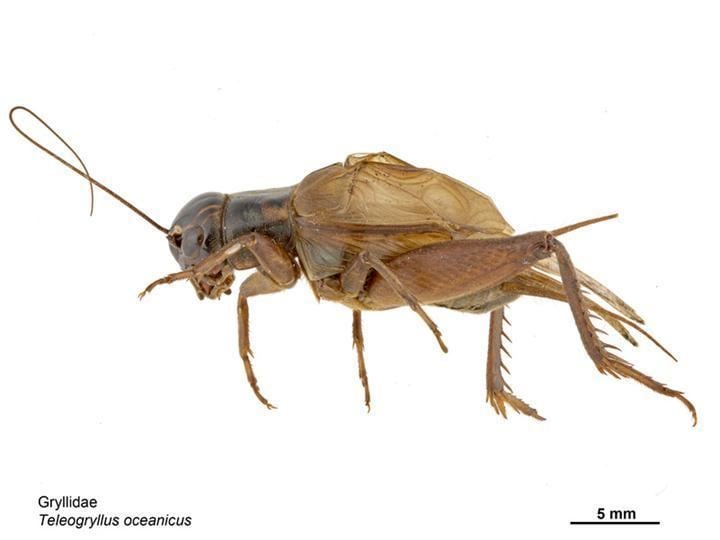Superfamily Grylloidea Rank Species | Phylum Arthropoda Family Gryllidae Higher classification Teleogryllus | |
 | ||
Similar Cricket, Teleogryllus, Field cricket, Insect, Gryllus | ||
Teleogryllus oceanicus song
Teleogryllus oceanicus, commonly known as the Australian, Pacific or oceanic field cricket, is a cricket found across Oceania and in coastal Australia from Carnarvon in Western Australia and Rockhampton in north-east Queensland
Contents
- Teleogryllus oceanicus song
- Robbing and dodging in rats rattus norvegicus and field crickets teleogryllus oceanicus
- Song Production
- Courtship
- Male Male Competition
- Predators
- Bat predation
- Ormia ochracea parasitism
- Flatwing Wing Morph
- References

T. oceanicus populations in Hawaii arose through human-assisted introduction. It is currently unknown whether T. oceanicus was introduced to Hawaii in 1877 by area trade ships, or 1500 years ago with the original Polynesian settlers. Microsatellite comparisons support the idea that the Hawaiian T. oceanicus colonization originated in the Western islands and then spread East.

T. oceanicus crickets are black to dark brown in coloration with longitudinal stripes on the back of the head. Males average between 28–35 mm in length, and the females are typically longer due to the ovipositor with an average of 33–42 mm. These crickets are typically found on soil ground hiding in fissures or holes in the terrain, and are typically only found in high numbers in landscapes that provide a good deal of cover.

T. oceanicus may also be referred to as the black field cricket, a common name it shares with Teleogryllus commodus. The two species are nearly morphologically indistinguishable, the exception being that T. oceanicus males have a greater number of file teeth on their wings. T. oceanicus was originally regarded taxonomically as a geographic race of T. commodus, but was later recognized as a distinct species as growing evidence of reproductive isolation and differences in calling sound were reported. The two species' geographic ranges remain mostly separate with the exception of small overlap zones in Eastern Australia. There have been no reports of hybridization between the species in this overlap zone, thought to be due to differences in calling song acting as a pre-zygotic barrier. No character displacement has been observed in either species in this overlap region. Unlike T. commodus which lays eggs only a single time per season, T. oceanicus crickets breed year round.

Robbing and dodging in rats rattus norvegicus and field crickets teleogryllus oceanicus
Song Production
Like most cricket species, Teleogryllus oceanicus males produce a calling song to attract potential female mates. Crickets produce the sound of their calls using a "file-scraper" system where, as the male opens and closes its wings, a plectrum (scraper) located on the posterior side of the left wing is rubbed against a filed vein located on the right wing. Structures called the harp and mirror allow the vibrations to resonate, producing the sound that we hear.
Courtship
Upon being approached by another individual, the male cricket will make antennal contact with the visitor. This contact allows a form of communication through chemoreception, and is important in determining the sex of the other individual. If the visitor is identified as a female, the male will begin the courtship behavior. During courtship, the male will begin singing the courtship song, which is much softer than the calling song, and is made of 7-10 amplitude-modulated chirps followed by a long and fast trill. As courtship progresses, the male will continue to stridulate and stroke the body of the female with his antennae. The female may respond by turning towards the male and contacting his abdomen with her forelegs, antennae and palpi. The male will then flatten his abdomen and spread his forewings, allowing the female to mount him, ultimately leading to copulation. During copulation, the male transfers his sperm to the female via spermatophore. After spermatophore transfer is complete, the male will attempt to remain in contact with the female to prevent her from removing the spermatophore. Unguarded female crickets have been shown to attempt to remove the spermatophore shortly after copulation. In crickets, male guarding behavior duration is closely related to the time it takes to complete sperm transfer.
Male-Male Competition
If a calling male cricket encounters another cricket, he will make antennal contact with the stranger individual to recognize the sex of the visitor. If the visitor is found to be another male, the calling male will begin aggressive behaviors. A male begins by singing an aggression song to the rival male, which results in the rival reciprocating, or retreating. Male conflicts involve antennal contact, lunging, aggressive chirping, and biting. Outcomes of fights depend on multiple factors, including differences in size, territory residency, differences in behavior, and fighting experience. Dominant males who have previously won fights are much more likely to win future fights. Males who have won 5 consecutive fights have been shown to have an 87% probability of winning the next. A male cricket's aggression song changes as a result of fight outcome (being enhanced after a win or reduced after a loss) thereby reinforcing a male's dominance or submission. Because conflicts can be very costly, winning fights may serve as an honest indicator of a male individual's fitness which can be assessed by females. A male's dominance also has a post-copulation effect by influencing fertilization success. Dominant males produce higher quality ejaculate, leading to females laying more eggs when mated to a dominant male compared to a subordinate male. Rather than focus on ejaculate quality, subordinate males up-regulate the production of their cuticular hydrocarbons to appear more attractive to females.

Predators
Like other small insects, Teleogryllus oceanicus crickets are subject to predation from many sources. This includes other insects, rodents, lizards, and mammals. Sexual signals used to attract a mate are often conspicuous and can by exploited by "eavesdropping" predators or parasites. Secondary traits that evolved via sexual selection may therefore be simultaneously opposed by natural selection. These species are then presented a conflict between mate attraction and survival. Male crickets are especially vulnerable to attack due to their conspicuous calling song. While this behavior is vital for mate attraction, it also gives up the calling individual's locations to nearby predators, especially those which hunt using acoustic cues. The most common acoustically oriented predators to pose a threat are insectivorous bats. For some T. oceanicus populations in Hawaii, the parasitoid fly species Ormia ochracea also poses a great threat.
Bat predation
Bats are very well equipped to prey upon crickets. While some bats rely purely on mid-flight echolocation to locate their prey, other species locate their prey through passive listening, orienting towards sounds made by the prey, and often emitting a fainter echolocation call as they approach their target. Teleogryllus oceanicus crickets have been shown to be able to distinguish a range of echolocation frequencies, responding with avoidance flight away from the bats. Multiple species of bats (Nyctophilus major and N. geoffroyi) have been shown to prefer trills in the cricket song compared to chirps. As a result, male crickets prefer to call from shelter, and the calls from males in shelter contain a greater number of trills than those emitted by a non-sheltered male.
Ormia ochracea parasitism
Ormia ochracea is an acoustically-orienting parasitoid fly that is native to North America, but has also been introduced to Hawaii. Females of this species are able to locate singing male Teleogryllus oceanicus crickets using a hearing apparatus evolutionarily convergent to T. oceanicus females. Once the singing male has been located, the female fly lays eggs on and around the male cricket, allowing her larvae to burrow into the host. The larvae eat and grow inside the cricket, emerging roughly 7 days later to pupate, killing the male cricket in the process.
